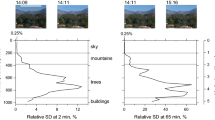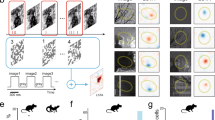Abstract
The light reflected from an object depends not only on the surface properties of this object but also on the illuminant. The same is true for the excitations of the photoreceptors, which serve as the basis for the perceived colour. However, our visual system has the ability to perceive constant surface colours despite changes in illumination1. The average chromaticity of the retinal image of a scene depends on the illumination, and thus might be used by the visual system to estimate the illumination and to modulate the correction that subserves colour constancy2,3,4. But this measure is not sufficient: a reddish scene under white light can produce the same mean stimulation as a neutral scene in red light. Higher order scene statistics—for example, the correlation between redness and luminance within the image—allow these cases to be distinguished. Here we report that the human visual system does exploit such a statistic when estimating the illuminant, and gives it a weight that is statistically appropriate for the natural environment.
This is a preview of subscription content, access via your institution
Access options
Subscribe to this journal
Receive 51 print issues and online access
$199.00 per year
only $3.90 per issue
Buy this article
- Purchase on Springer Link
- Instant access to full article PDF
Prices may be subject to local taxes which are calculated during checkout



Similar content being viewed by others
References
Kraft, J. M. & Brainard, D. H. Mechanisms of color constancy under nearly natural viewing. Proc. Natl Acad. Sci. USA 96, 307–312 (1999).
Buchsbaum, G. A. Spatial processor model for object colour perception. J. Franklin Inst. 310, 1–26 (1980).
Land, E. H. Recent advances in retinex theory. Vis. Res. 26, 7–21 (1986).
Gershon, R. & Jepson, A .D. The computation of color constant descriptors in chromatic images. Color Res. Appl. 14, 325–334 (1989).
Gilchrist, A. L. & Ramachandran, V. Red rooms in white light appear different from white rooms in red light. Invest. Ophthalmol. Vis. Sci. 33, 756 (1992).
Lee, H.-C. Method for computing the scene–illuminant chromaticity from specular highlights. J. Opt. Soc. Am. A 3, 1694–1699 (1986).
Tominaga, S. & Wandell, B. A. Standard surface-reflectance model and illuminant estimation. J. Opt. Soc. Am. A 6, 576–584 (1989).
D'Zmura, M. & Lennie, P. Mechanisms of color constancy. J. Opt. Soc. Am. A 3, 1662–1672 (1986).
Maloney, T. M. & Yang, J. N. in Colour Perception: From Light to Object (eds Mausfeld, R. & Heyer, D.) (in the press).
Funt, B. V. & Drew, M. S. Color space analysis of mutual illumination. IEEE Trans. Pattern Anal. Mach. Intell. 15, 1319–1326 (1993).
Funt, B. V., Drew, M. S. & Ho, J. Color constancy from mutual reflection. Int. J. Comp. Vis. 6, 5–24 (1991).
Bloj, M., Kersten, D. & Hurlbert, A. C. Perception of three-dimensional shape influences colour perception through mutual illumination. Nature 402, 877–879 (1999).
Bäuml, K.-H. Color appearance: effects of illuminant changes under different surface collections. J. Opt. Soc. Am. A 11, 531–542 (1994).
MacLeod, D. I. A., & Golz, J. in Colour Perception: From Light to Object (eds Mausfeld, R. & Heyer, D.) (in the press).
Mausfeld, R. Color in Color Vision (eds Backhaus, W. G. K., Kliegel, R. & Werner, J. S.) 219–250 (De Gruyter, Berlin, 1998).
Mausfeld, R. & Andres, J. A reduced variance of receptor codes in chromatic scenes activates a ‘discounting the illuminant’ mechanism. Perception 27 (Suppl.), 42 (1998).
Mausfeld, R. & Andres, J. Second order statistics of colour codes modulate transformations that effectuate varying degrees of scene invariance and illumination invariance. Perception (in the press).
Ruderman, D. L., Cronin, T. W. & Chiao, C. C. Statistics of cone responses to natural images: implications for visual coding. J. Opt. Soc. Am. A 15, 2036–2045 (1998).
MacLeod, D. I. A. & Boynton, R. M. Chromaticity diagram showing cone excitation by stimuli of equal luminance. J. Opt. Soc. Am. 69, 1183–1186 (1979).
Golz, J. & MacLeod, D. I. A. Influence of scene statistics on color constancy. Invest. Ophthalmol. Vis. Sci. 40 (Suppl.), S749 (1999).
Eskew, R. T., McLellan, J. S. & Giulianini, F. in Color Vision: from Genes to Perception (eds Gegenfurtner, K. R. & Sharpe, L. T.) 345–368 (Cambridge Univ. Press, New York, 1999).
Jenness, J. W. & Shevell, S. K. Color appearance with sparse chromatic context. Vis. Res. 35, 797–805 (1995).
Brown, R. O. & MacLeod, D. I. A. Color appearance depends on the variance of surround colors. Curr. Biol. 7, 844–849 (1997).
Webster, M. A. & Mollon, J. D. Adaptation and the color statistics of natural images. Vis. Res. 37, 3283–3298 (1997).
Brainard, D. H. & Freeman, W. T. Bayesian color constancy. J. Opt. Soc. Am. A, 14, 1393–1411 (1997).
D'Zmura, M., Iverson, G. & Singer, B. in Geometric Representations of Perceptual Phenomena (eds Luce, D., D'Zmura, M., Hoffman, D., Iverson, G. & Romney, A.) 187–202 (Lawrence Erlbaum Associates, Mahwah, 1995).
Forsyth, D. A. in AI and the Eye (ed. Blake, A. & Troscianko, T.) 201–227 (Wiley, Chichester, 1990).
Forsyth, D. A. A novel algorithm for color constancy. Int. J. Comp. Vis. 5, 5–36 (1990).
Wyszecki, G., & Stiles, W. S. Color Science: Concepts and Methods, Quantitative Data and Formulae 2nd edn 145–146 (Wiley, New York, 1982).
Stockman, A., MacLeod, D. I. A. & Johnson, N. E. Spectral sensitivities of the human cones. J. Opt. Soc. Am. A 10, 2491–2521 (1993).
Acknowledgements
We thank D. L. Ruderman, T. W. Cronin and C. C. Chiao for their spectral data of natural scenes. This work was supported by the National Eye Institute. J. Golz was supported by the German–American Fulbright Commission.
Author information
Authors and Affiliations
Corresponding author
Ethics declarations
Competing interests
The authors declare no competing financial interests.
Rights and permissions
About this article
Cite this article
Golz, J., MacLeod, D. Influence of scene statistics on colour constancy. Nature 415, 637–640 (2002). https://doi.org/10.1038/415637a
Received:
Accepted:
Issue Date:
DOI: https://doi.org/10.1038/415637a
This article is cited by
-
A simple image-based method for online moisture content estimation of iron ore green pellets
Journal of Iron and Steel Research International (2023)
-
The problem of perceptual invariance
Synthese (2021)
-
A Geometric Model of Brightness Perception and Its Application to Color Images Correction
Journal of Mathematical Imaging and Vision (2018)
-
Do specular highlights and the daylight locus act as cues for estimating illumination color from a single object?
Optical Review (2017)
-
Visual and spectrophotometric observations related to histology in a small sample of bruises from cadavers
Forensic Science, Medicine, and Pathology (2011)
Comments
By submitting a comment you agree to abide by our Terms and Community Guidelines. If you find something abusive or that does not comply with our terms or guidelines please flag it as inappropriate.



